Proof Trade Dollars Stand Out In Stack’s Bowers Rarities Night
From over 400 coins in the Rarities Night auction, a group of proof trade dollars were particularly noteworthy.
As part of the Rarities Night session late in the day on March 26 at the Stack’s Bowers (SBG) headquarters in Costa Mesa, California, an impressive run of Proof Trade Dollars was offered. Before the auction, the coins were available for viewing at the SBG headquarters, at the SBG office in New York and at the Whitman Expo in Baltimore, which was held the week before the auction sessions.
There were thousands of coins in the entire Stack’s Bowers auction extravaganza and more than four hundred coins in this Rarities session. It is not practical to discuss all or even a large number of them here. As a group, the Proof Trade Dollars jumped out at me. As so many Proof Trade Dollars have been dipped-white, substantially cleaned, or otherwise modified, the attractive natural tones on the surfaces of several of these were refreshing and very appealing.
Although business strikes were struck just from 1873 to 1878, Proof Trade dollars date from 1873 to 1885. It is unsurprising that collectors in the 1870s and 1880s demanded the Proofs, as many Proof Trade dollars are stunning. Toning that relates to original mint wrapping is often especially colorful.
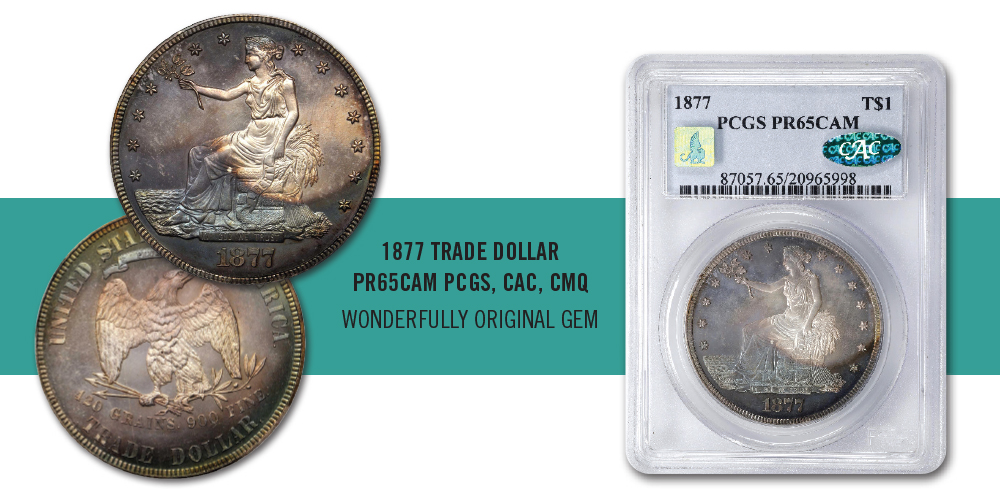
A CAC approved, PCGS certified Proof-65 Cameo 1877 also has a CMQ sticker from Stack’s Bowers. According to the SBG catalogue, this 1877 Trade dollar is from the James DeAngelis Collection. This consignment included other CAC approved, naturally toned silver coins.
The toning on this 1877 provides meaningful examples of natural colors that often developed on Proof Trade Dollars. The shades of blue, blue-green, pale-green, russet-gray, creamy tan-lilac and light brown are educational and entertaining.
On March 31, shortly after this auction, Greysheet-CAC Bid for this coin was increased from $13,800 to $14,300. On April 4, the CPG®-CAC medium retail estimate was $17,300. Unsurprisingly, this coin realized $15,600, though it is curious that Stack’s Bowers auctioned this same coin in the same holder for this exact same price, $15,600, on June 22, 2018. By itself, this point is not a compelling fact. It is consistent, though, with the view that most scarce U.S. silver coins, especially Proof Type coins, did not join the boom in rare date U.S. gold that first became apparent in January 2021 and lasted at least until early 2023. Demand for rare date gold coins remains much more intense than demand for classic U.S. silver type coins.
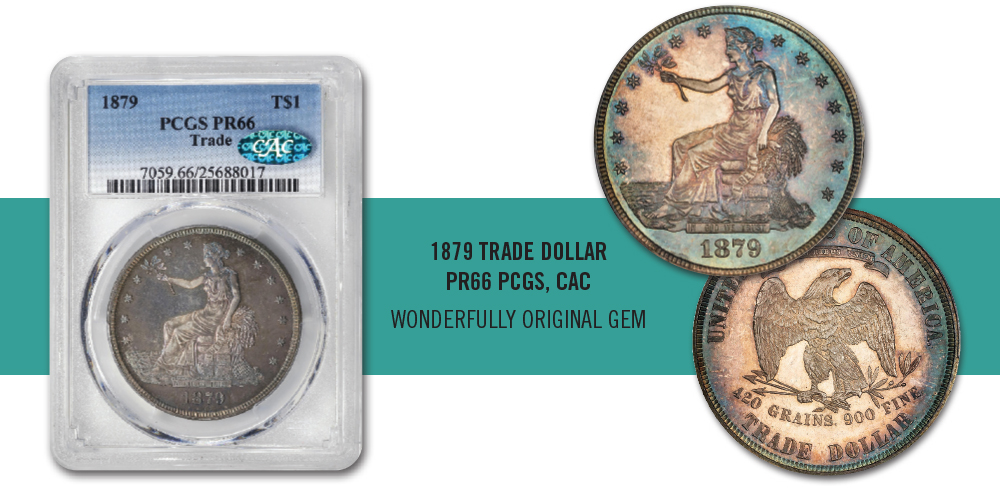
On March 26, a CAC approved, PCGS certified Proof-66 1879 Trade dollar realized $13,200. The CPG®-CAC medium retail estimate is or was $12,000. The strong result did not surprise me at all, though I admit to having had, in the past, a conflict of interest regarding this coin.
This same 1879 Trade dollar was auctioned by Stack’s Bowers back on November 23, 2021 for $9,600. I advised a client to buy it, though he did not do so. In 2021, I figured that a fair collector price was $10,500 and a very strong price would have been $13,000, approximately the result on March 26, 2024. Although the Greysheet-CAC Bid price for this coin has been increased three times since November 2021 from $8,740 then to $8,800 in June 2022, to $9,360 on May 31, 2023, and finally to $9,600 on March 31, 2024, I really find that its market value is only 5% higher now than it was in November 2021. Auction results can be below-market, wholesale, retail or super-strong depending upon who is bidding at a moment in time and the motivations of the respective bidders.
This 1879 Trade dollar is an excellent coin, though it is not the liveliest Proof Trade Dollar that I have ever seen. The obverse has the eye appeal of a 65 grade coin and the technical rating of a 67 grade coin, for a net grade in the middle of the 66 range. The grade of the reverse is a few tenths of a point higher than that of the obverse, in my opinion.
There are hardly any contact marks and hairlines on this coin, as best as I could tell. This coin has normal blue and russet colors, textbook toning for a Proof Trade Dollar. There is much green-gray on this 1879, too.
The eagle on the reverse really glows! The brown-russet outer areas on the reverse contrast well with the central parts. I recommended this coin in 2021 and I liked it again in 2024, though some collectors prefer flashier Proof Trade Dollars. I prefer originality to animation.
The PCGS certified Proof-66 1879 in this auction was average, at best, for its certified grade. Some of the tones capture attention. The $9,600 result was strong and not a great deal.
The next lot, a third 1879, was PCGS certified as Proof-65 Cameo and CAC approved. The Greysheet-CAC Bid was $8,350 and the CPG®-CAC medium retail value was $10,450 on April 4. In a Legend auction on October 28, 2021, this same coin brought $10,281, a notably strong price. In my view, the current auction result of $9,000 was moderate to strong.
This coin scores higher in the category of eye appeal than it does in the technical category. An overall certified grade of 65 is unsurprising. Each individual coin will appeal to some collectors more so than others. Price guides cannot account for all very pertinent subjective factors. There is a need to see coins in actuality to fairly interpret them.
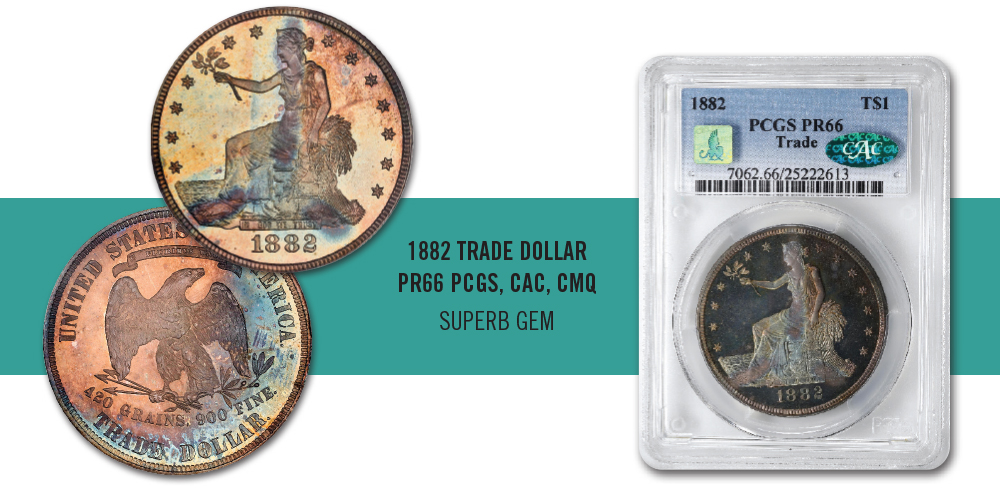
The 1882 Trade Dollar was one of the coolest coins in the whole Rarities session of March 27. It is really awesome. It was PCGS certified Proof-66. There are CAC and CMQ stickers on the holder.
Miss Liberty shows off yellow, pale-green, blue, violet and red colors. These contrast well with blue-gray fields. The stars feature different colors and are memorable. The reverse is mostly orange-russet and really glistens.
Greysheet-CAC Bid was recently increased from $9,360 to $9,600. The CPG®-CAC medium retail estimate was $12,000 on April 6. This same coin realized $12,925 in a Legend auction on May 26, 2022, though I figure this coin’s value was around the same in March 2024 as it was in May 2022. The $14,400 result this time was unsurprising. I could certainly understand at least two bidders being enthralled by this 1882 Trade Dollar.
It is curious that Proof-65 and higher grade Trade Dollars were considered among the most important of all U.S. type coins during the 1980s and 1990s. They were then far more famous and sought after than they have been so far in the twenty-first century.
In the April 6, 1990 issue of the CDN weekly newsletter, Greysheet Bid for a PCGS or NGC certified Proof-65 Trade dollar was $12,500. Thirty-four years later, on April 6, 2024, Greysheet Bid for a PCGS or NGC certified Proof-65 Trade dollar by type was $5,000. It could be somewhat fairly theorized, however, that a PCGS or NGC certified Proof-65 Trade dollar in 1990 might very well qualify for a Proof-66 certification in 2024.
On April 6, 2024, Greysheet Bid for a PCGS or NGC certified Proof-66 Trade Dollar was $7,600 and Greysheet-CAC Bid was $9,600. Both numbers are well under the Greysheet Bid of $12,500 for a Proof-65 Trade dollar on April 6, 1990, twenty-four years ago.

Download the Greysheet app for access to pricing, news, events and your subscriptions.
Subscribe Now.

Subscribe to The Greysheet for the industry's most respected pricing and to read more articles just like this.
Source: Greg Reynolds








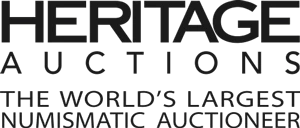
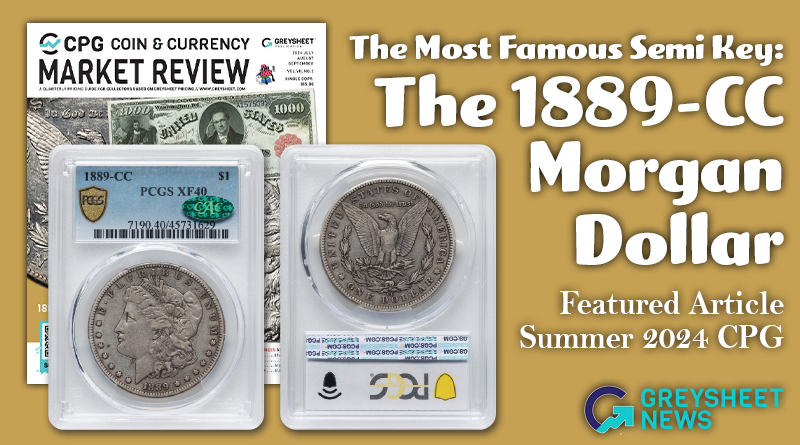
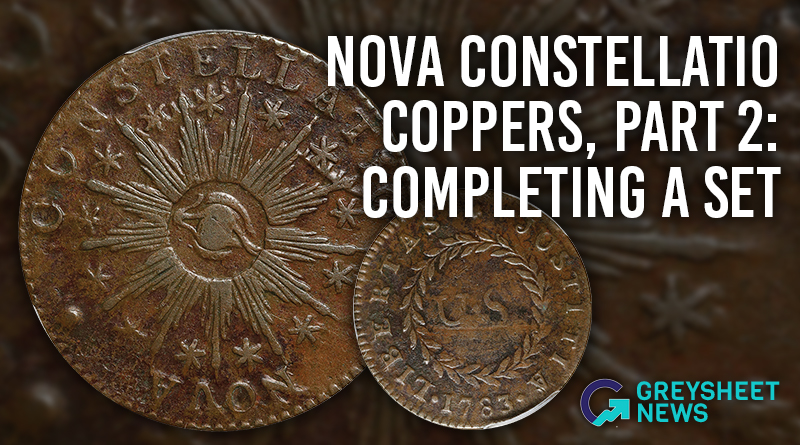
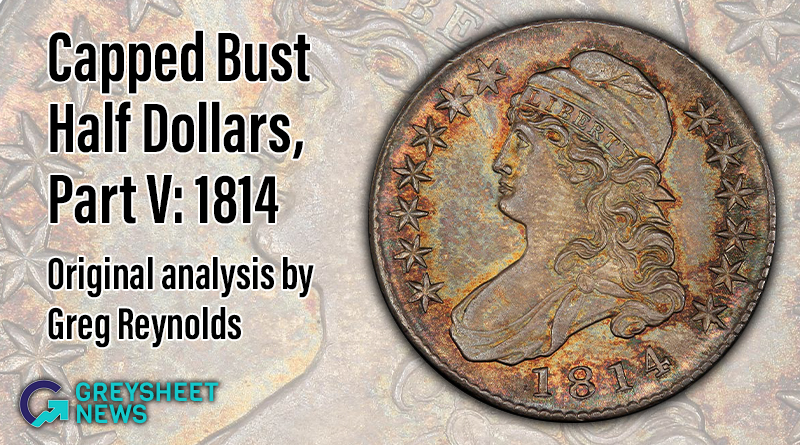
Please sign in or register to leave a comment.
Your identity will be restricted to first name/last initial, or a user ID you create.
Comment
Comments